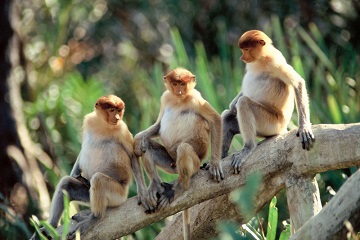Researchers of IPB Designed the Ecotourism of Bekantan in Tapin District, South Kalimantan

Researchers of Department of Conservation of Forest Resources and Ecotourism, Faculty of Forestry, Bogor Agricultural University (Fahutan-IPB), Ratna Agustine, Prof. Hadi Sukadi Alikodra, and Dr. Entang Iskandar, conducted the research about the planning of the ecotourism development model of bekantan in Rawa Gelam Forest, Tapin District, South Kalimantan. Prof. Alikodra said, the bekantan (Nasalis larvatus) was the endemic animal to Kalimantan Island whose life was depended on the river. One of the predominant habitats of the bekantan was Rawa Gelam Forest located on the side of Muning River Canal, Tapin District, South Kalimantan Province. There were at least 77 individual bekantan which lived in the swamp forest sacs dominated by the type of gelam (Melaleuca cajuputi).
Prof. Alikodra also said, the remaining Rawa Gelam forest in Tapin District in 2013 was 3,471 hectares. In order to protect the bekantan and its habitat, then Tapin District Government had established an important value area for the conservation of bekantan of 90 hectares as stated in the Decree (SK) of the Regent of Tapin No. 188.45/060/KUM/2014. This research was important to compose the development model in the Tapin Bekantan Ecotourism Area (KEBT).
“Wildlife-based ecotourism in the forest area is considered to be an alternative form of the wildlife management with regard to safeguard and still generate the economic benefits for both the management and the communities surrounding the forest area,” said Prof. Alikodra.
“But to plan the management of wildlife, it is necessary to have the knowledge and the proper planning and in accordance with the wildlife condition. The goal to be achieved in the ecotourism development of the bekantan in Tapin, namely the preservation of swamp forest species and ecosystem, the maintenance of socio-cultural conditions of the community, and the increasing economy for the community, as well as the government,” he said.
The result of the research showed, the color of the Bekantan Ecotourism Area of 90 hectares were dominated by the wetland (57 hectares), and the rest was the burnt vegetation (33 hectares) which had been succeeded. At this location, it was found 31 species of plants that were dominated by gelam and pulantan (Alstonia angustiloba).
This efforts to expand the essential area from 90 hectares to 1,912 hectares were also needed to provide the security for the bekantan and the Rawa Gelam Forest. The area of ecotourism of the bekantan was also directed as a leading tourist destination in Tapin District, so it was necessary to develop the facilities and accommodation to increase the local revenue (PAD) as well as the business opportunities for the community.(AT/ris)



